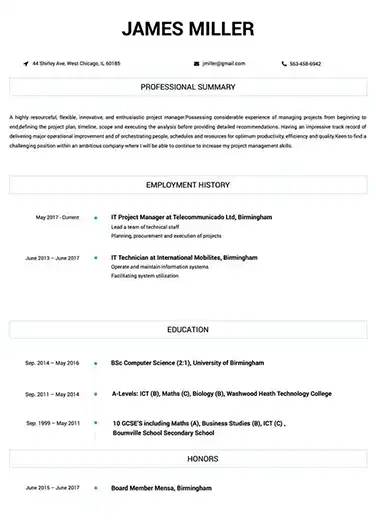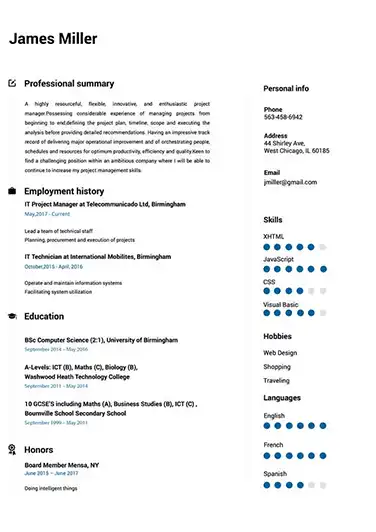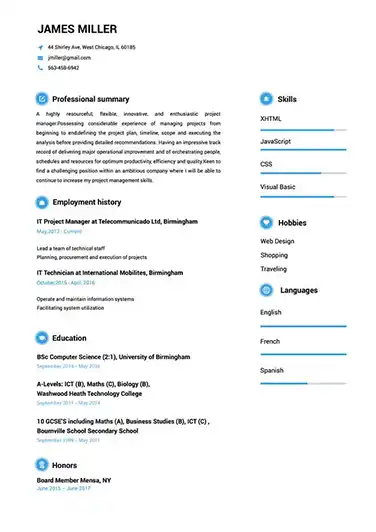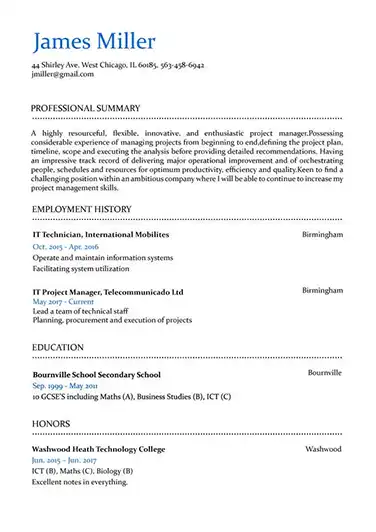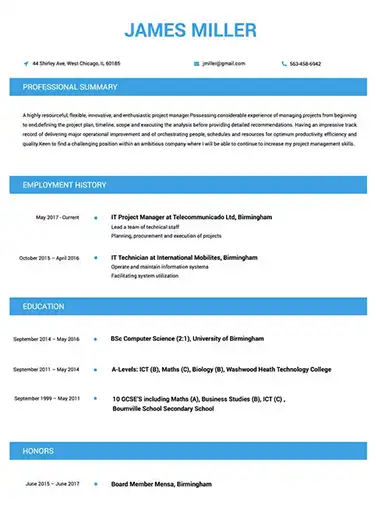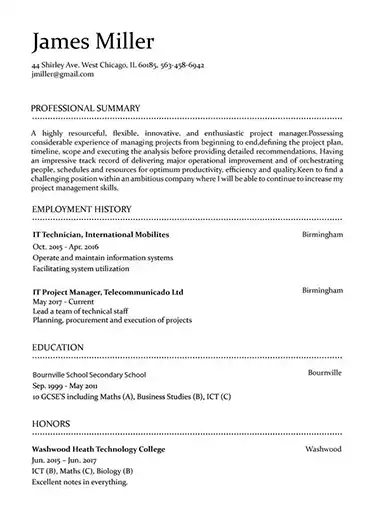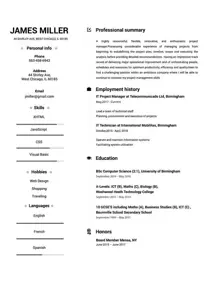 Use This Template
Use This Template
Build your resume in 15 minutes
Create an awesome resume that meets the expectations of potential employers with our selection of professional, field-tested resume templates.
welder: Resume Samples & Writing Guide
quinnnate@yandex.com
759-586-9727
Employment history
- Determine the appropriate welding equipment or method based on requirements
- Select and set up the correct welding equipment for the job
- Follow safety guidelines and standards
- Calculate and set controls to regulate the welding process and heat input
- Maintain and repair welding, brazing, and soldering equipment
- Develop and maintain good working relationships with other trades
- Monitor the fitting, burning, and welding processes to avoid overheating
- Follow safety guidelines and standards
- Inspect completed work for conformance to specifications
Education
Skills
Do you already have a resume? Use our PDF converter and edit your resume.
stanley-gray@mail.com
658-189-8516
Employment history
- Use hand tools to grind, file and smooth welds
- Inspect completed work for conformance to specifications
- Develop and maintain good working relationships with other trades
- Perform preventative maintenance on welding equipment
- Monitor the fitting, burning, and welding processes to avoid overheating
- Read and interpret blueprints and drawings
- Select and set up the correct welding equipment for the job
- Use hand tools to grind, file and smooth welds
- Follow safety guidelines and standards
Education
Skills
danny_baker@yahoo.com
932-449-8808
Employment history
- Set up and operate manual or semi-automatic welding equipment
- Develop and maintain good working relationships with other trades
- Inspect completed work for conformance to specifications
Education
Skills
griffinisaac56@protonmail.com
778-693-0931
Employment history
- Determine the appropriate welding equipment or method based on requirements
- Calculate and set controls to regulate the welding process and heat input
- Operate welding equipment to join, fabricate, and repair metal components
- Follow safety guidelines and standards
- Inspect completed work for conformance to specifications
- Maintain and repair welding, brazing, and soldering equipment
- Set up and operate manual or semi-automatic welding equipment
- Set up jigs, clamps and fixtures to hold and position pieces
- Calculate and set controls to regulate the welding process and heat input
Education
Skills
markadams76@yandex.com
929-954-7517
Employment history
- Perform preventative maintenance on welding equipment
- Use hand tools to grind, file and smooth welds
- Inspect completed work for conformance to specifications
- Select and set up the correct welding equipment for the job
- Determine the appropriate welding equipment or method based on requirements
- Perform preventative maintenance on welding equipment
- Set up jigs, clamps and fixtures to hold and position pieces
- Follow safety guidelines and standards
- Maintain and repair welding, brazing, and soldering equipment
Education
Skills
Not in love with this template? Browse our full library of resume templates
Welding is a metalworking trade with a history that stretches all the way back to ancient times, specifically to the Bronze Age. In fact, the earliest examples of welding are more than 2000 years old! Needless to say, welding has transformed significantly over the years as a profession, especially with the development of new techniques and machinery.
So what is the modern-day job scope of a welder? As Career Explorer explains, “A welder is a skilled tradesman who joins metal together, or fills and repairs holes on metal constructions through the use of intense heat and gas. Welders work on all types of industrial, manufacturing, and construction applications; some even work underwater to repair oil rig foundations, ship hulls and other types of subaquatic structures.”
Given how crucial welders are in a variety of industries, it’s no wonder they’ve stood the test of time. That being said, future job growth in this sector isn’t exactly rapid. According to the Bureau of Labor Statistics, employment of welders is projected to grow 3 percent from 2018 to 2028, which is 2 percent slower than the average for all occupations.
So what can you do to secure a long, bright future as a welder? You need to create a resume that screams “Pick me!” to recruiters. The only thing that’s standing in your way of doing so is your lack of insider resume-making knowledge. Fortunately, you can read the following welder resume example and guide to get up to speed. It will teach you exactly what you need to do in order to create an unbeatable welder resume including:
- The 6 essential sections every welder resume must have
- Which skills and achievements are most valuable to include
- How to correctly list additional training and certifications
- Tips to keep in mind if you’re an entry level welder
- How to create a professional resume in minutes
1. Multiple Template Examples
2. How to Write a Job-Winning Welder Resume
How should you format your resume?
When a recruiter scans over your resume, one of the first impressions they should have is how logically organized it is. The resume format that’s been shown to make recruiters think this is a reverse-chronological format. After all, it’s the most common resume format around as it’s considered to be most recruiters’ top pick.
The reason reverse-chronological format is ideal to use if you’re an experienced welder is because it makes the growth you’ve undergone as a professional crystal clear to a recruiter. The format does this by ordering your work experiences from your current or most recent position and then working backwards from there.
When you’re in the midst of formatting your resume, you’ll also need to be mindful of the optimal resume layout to use. You won’t want to tinker with standard layout guidelines if you want to impress. We’ve highlighted the best practices for welder resumes below:
- Number of Pages: One only.
- Fonts to Use: Standard fonts that are well-known to recruiters such as Verdana and Calibri.
- Fonts to Avoid: Any fonts that appear childish, such as Alba and Jokewood.
- Margins: 1 inch on all sides.
- Line Spacing: 1 or 1.15.
- Header size: 14-16 point size.
- Text size: 11-12 point size.
Which sections should be included in a welder resume?
Before hitting the “send” button to submit your job application, you'll need to ensure your resume includes all of the sections a recruiter will be expecting to see. We’ve listed the 6 fundamental sections that every welder resume should include below:
- Contact Information: Include standard contact information at the top of your resume such as your name, phone number, email address, and home address. It’s also helpful to include your LinkedIn profile URL.
- Resume Objective or Resume Summary: A concise overview of why a recruiter should view you as the most suitable welder for the position.
- Employment History: An insight into your most relevant professional experiences. For each job, include the name of the company, your position, your most impressive achievements, as well as the period of time you worked there.
- Education: Vital details about your relevant educational background.
- Training and Certifications: Details about any training and certifications you’ve undertaken to develop your skills and knowledge as a welder.
- Skills: A list of hard and soft skills you possess that a recruiter would be interested in learning about.
Pro tip: In most cases, it’s not necessary to include any information about your hobbies, interests, or volunteer in your resume. Only include sections about them if you’re requested to or if you’re an entry level candidate whose resume is looking very bare. If you must include any of these sections, try to make them as relevant as possible to welding.
Where should you include additional training and certifications you have as a welder? How can you do so correctly?
Welding is a profession in which you never stop learning. If you’ve undertaken any additional training or certifications that show off your efforts to develop professionally, it’s crucial to feature them front and center in your resume.
Even though it’s not mandatory for welders to receive any particular formal training or certifications, recruiters are known to look favorably on candidates who have taken the initiative to further their welding skills and knowledge.
There are a variety of training and certifications you can include to seriously strengthen your resume. For example, the American Welding Society offers the following national certifications:
- Certified Welder
- Certified Welding Engineer
- Certified Robotic Arc Welding
- Certified Welding Inspector (CWI)
- Senior Welding Inspector (SCWI)
- Certified Welding Educator (CWE)
- Certified Resistance Welding Technician (CRWT)
- Certified Radiographic Interpreter (CRI)
- Certified Welding Supervisor (CWS)
Your workplace may also have offered in-house training. Given the importance of safety in the industry, you should also consider adding any internal or external safety training or certifications.
In order to list any relevant training or certifications you have to your name, add them to your resume’s “Training and Certifications” section. When you’re working on this section, make sure to avoid writing extensively about your experiences like this candidate did
TRAINING AND CERTIFICATIONS
I can now proudly call myself a “Certified Welder” after attending and completing the American Welding Society’s Certified Welder Program in 2019. In order to receive my certification, I had to meet a number of requirements including completing a welder performance qualification test. It was a very challenging program, but I made it in the end!
The problem with the above example is that it’s far too wordy and includes a lot of unnecessary detail a recruiter won’t have time to process.
To correctly list your additional training and certifications, provide the following key details in list form:
- The name of the training or certification
- The institution or company that provided it
- The state it was held in
- The year you received your training or certification
With this in mind, the correct way of writing the above candidate’s certification is as follows:
TRAINING AND CERTIFICATIONS
- Certified Welder Program, American Welding Society, California, 2019
Pro tip: If you believe it’s relevant to share more detailed information about a training program or certification you undertook, why not do so in your cover letter?
What skills should you mention? How do you correctly do so?
The skills you mention on your resume should be a direct reflection of the skills a recruiter is seeking from their ideal candidate. In other words, the skills you mention should be relevant to the specific job you’re applying for. The good news is that figuring out which skills a recruiter values is easier that welding two pieces of sheet metal together. All you need to do is scan the job ad for keywords.
Keywords is a term used to describe the words in a job ad that represent the qualities a perfect candidate has in the eyes of a recruiter. As the expectations for each job will change, the keywords you will find in each job ad will too.
In order to find the skills a recruiter is after, look for skills-focused keywords. Keep in mind that these skills won’t just include technical welding skills, aka “hard skills.” They will also include interpersonal and communication based skills, which are known in the HR industry as “soft skills.”
To give you an idea of the hard and soft skills you may come across in your job search, take a look at the examples below. We scanned real-life job ads to find them, so they’re as legitimate as it gets!
Hard skills
- Operating grinding equipment
- Performing full penetration welds
- Welding broken or cracked parts of machinery and equipment
- Preparing surfaces for welding
- Removing slag from the weld line
- Preparing sketches and basic reports of work performed
- Driving and stocking a welding truck
- Setting up welding equipment including semi-automatic and/or machine guided welding machines
- Adjusting equipment to proper voltage and amperage for the type of welding to be performed
- Reading blueprints
Soft skills
- Observing all standard safety practices
- Team player
- Organized
- Oral and written communication abilities
- Ability to follow instructions
- Dependability
- Punctuality
- Self-monitoring
- Trainability
- Working well under pressure
If you’re now wondering if you can just sprinkle your resume with the keywords you find and be done with it, the answer is a strong, “No!” You’ll need to first work out which ones you hold and then incorporate them strategically into the following 3 sections:
- Resume Objective or Resume Summary: Include 1 or 2 stand out skills you possess that you’d like the recruiter to know you have from the get-go.
- Employment History: Focus each achievement around 1 or 2 skills (more on this below).
- Skills: Include 6 to 8 relevant skills in a list form.
Pro tip: Considering that there are over 100 different welding methods, it’s important to be specific about which ones you’re skilled in.
How to highlight your achievements
Highlighting your achievements doesn’t need to be a headache if you know what you’re doing. The secret to selecting the right achievements is to choose those that will allow you to naturally incorporate keywords found in a given job ad. To learn more about keywords, make sure to read the section above.
It’s crucial to be natural when incorporating keywords because a recruiter will turn completely off your resume if they catch you keyword stuffing. Keyword stuffing describes when a candidate artificially adds keywords into their resume.
They may do this in an attempt to trick an applicant tracking system (ATS) into passing their resume. ATS is a human resources software many recruiters rely on to vet candidates’ resumes. It will analyze the suitability of each resume for a given role based on the presence or absence of keywords. While a candidate who keyword stuffs may initially be able to get away with it, a recruiter will catch them out eventually.
So what does keyword stuffing look like? Check out the following candidate’s achievement:
- Demonstrated thorough knowledge of safety standards as well as understanding of safety standards in all tasks.
We’re sure you’ve already worked out that this candidate was trying to keyword stuff the keyword “safety standards.” Given that they repeated it twice for no good reason, a recruiter would be able to instantly tell that they were trying to manipulate the ATS.
However, keyword stuffing isn’t the only reason a recruiter would be completely unimpressed by this achievement. It also doesn’t offer anything that would captivate a recruiter’s attention. After all, the candidate simply states the fact that they have knowledge and understanding of safety standards, but doesn’t provide an example of this in action.
As a rule of thumb, you should illustrate each achievement with a tangible example that makes it clear why it’s an achievement in the first place. You’ll get extra points if you can quantify your achievements with relevant numbers and statistics.
To recognize the impact doing so could have for your resume, we’ve rewritten the above candidate’s achievement with this in mind. Take a look at it for yourself:
- Demonstrated thorough knowledge and understanding of safety standards, resulting in a 100% safety rating in my employee reviews.
As you can see, providing an example to support your achievement – especially one that quantifies it – can make your achievements shine. Be sure to keep this in mind when you’re ready to write your own!
What physical requirements will you need to address?
When you’re analyzing a job ad, you’ll also need to keep your eyes peeled for any physical requirements that you’ll need to possess in order to be considered.
For example, one job ad we found stated that candidates must be able to:
- Adhere to large amounts of standing, walking, bending, squatting, sitting and lifting.
- Use arms and hands to signal, grab, hold, turn, push, and pull: objects, materials, controls and tools.
- Lift, carry, and move a certain amount of weight.
- Work at a certain height, climb ladders and stairways, and work off of platforms.
- Work in weathering conditions.
If you find any physical requirements in a job ad, make sure your resume makes it clear that you meet them (unless the recruiter asks you to address them in your cover letter instead). You can do so by incorporating them into your “Employment History” section. If appropriate, you may be able to feature a few in your “Skills” section as well.
How do you write a resume objective or summary? Which one should you use?
What if we told you there’s a section of your resume that can reframe how a recruiter views your entire application? This is exactly what a well-written resume objective or summary can do in just two to four sentences.
For recruiters, these sections offer an insight about candidates that they might not otherwise be able to obtain. For candidates, these sections provide an opportunity to explain to recruiters why they’re worth considering for a given position.
But before you start typing up both, you should keep in mind that you will only need to include one. So which one is most suitable for you? The answer couldn’t be more straightforward: If you’re an entry-level candidate, create a resume objective; if you’re an experienced candidate, create a resume summary. You can discover more about each one as well as some helpful good and bad examples below.
Resume objective
Recruiters can often spot an inexperienced candidate’s resume from a mile away due to how they write their resume objective. This is because inexperienced candidates tend to provide wishy-washy overviews of themselves that do little to draw the recruiter in. They also tend to convey a sense of desperation to get hired, even if it isn’t their intention to do so.
Take a look at the following candidate’s resume to get an idea of what we mean:
- Aspiring welder who is looking to get some professional experience in the world of welding. I have a number of great qualities that would make me a fantastic welder. I really want to work for Welding Plus and I would give anything to get hired.
If you were a recruiter, would you be interested enough to keep reading this candidate’s resume? Most recruiters would immediately give their whole resume a hard pass based on the fact that this candidate failed to frame themselves as a desirable candidate.
All the candidate has basically communicated to the recruiter is that they’re an aspiring welder who wants to get more experience. While they stated that they would “give anything” to get hired, they didn’t even bother to give the recruiter any indication of what the so-called “great qualities” they offer are.
The following candidate’s resume objective is a whole nother story:
- Highly-motivated aspiring welder who completed a rigorous 6 month apprenticeship at Welding Experts. I was commended for my skills in reading blueprints and preparing surfaces for welding as well as my dependability. I am eager to work for Welding Plus so I can harness these skills and forge a bright future at your company.
This candidate made the effort to offer the recruiter a deep but concise look at who they are as an aspiring welder. While this candidate is also inexperienced, their resume objective doesn’t overemphasize their lack of experience. Nor does it paint them as being desperate for a job – it instead conveys how enthusiastic they are to get their foot in the door and start working hard for Welding Experts.
Another one of the many stand out features of this resume objective is that it’s been specifically created for the particular company. The prior candidate didn’t even mention the company’s name, which is a telltale sign that they simply use the same resume objective each time. Recruiters despise generic resumes, so be sure to create a custom resume objective every time you apply for a new job.
Likewise to this candidate, you will also need to ensure that your attributes shine brightly in your resume objective. You can do this by focusing on any relevant experiences you’ve had. Even if you haven’t undertaken an apprenticeship like this candidate has, you can still mention the relevant hard and soft skills you offer. You can also highlight any relevant courses you’ve completed or any other eye-catching details that a recruiter would find relevant to discover.
Resume summary
The downfall of many experienced candidates’ resume summaries is that they say a whole lot of nothing. Perhaps this is because they assume that recruiters will get the detail they’re seeking when they read the rest of their resume.
The thing is, a recruiter might not even read on if they’re not impressed with your resume summary! After all, why would they bother doing so if they can instead spend their time reading the resumes of candidates who took the care to craft a meticulous resume summary?
If you’re wondering what a not-so great resume summary looks like, refer to our example below:
- Welder with several years of experience who has made a name for themselves for being a skilled welder. I am looking for a job at your company because I believe I would be a perfect fit for the position. I not only offer the qualities you’re after, but I also offer some additional ones that would be valuable in this role.
This resume summary might not look too bad to the untrained eye, but to a recruiter, it’s downright awful.
To put yourself in their shoes, take a closer look at it and ask yourself if you can tell:
- What type of welding the candidate does
- How long they have been working in the industry
- Why they would make a “perfect fit for the position”
- What qualities and skills they offer that the recruiter is apparently after
- What the additional qualities are that they purport to have
Your answer will surely be “No” for all of them because the candidate hasn’t provided any specific details about themselves or their professional experience or skills. So in short, they have made themselves out to be a fantastic pick for the position, without actually backing this up with any substantial evidence.
So what should you aim to do instead? Take a look at this shining example of a welder resume summary:
- Certified welder with 3+ years of experience who specializes in TIG welding. I believe I would be an ideal fit for the full time welding job at Complete Engineered Solutions due to my ability to work well under pressure as well as my ability to perform full penetration welds. I have also trained 20+ apprentices and would be eager to take more under my wing if I had the opportunity to work for your company.
This candidate’s attempt is extremely promising because they provide the recruiter with a meaningful overview not only of who they are, but also why they’re ideal for the job.
Take a look again at it and ask yourself if you can tell those same qualities we shared above. Are your answers any different? You should now have said “Yes” to all of them as this candidate effectively offered specific details about their professional experience and skills. They also backed up what they said with concrete examples.
Needless to say, this is a much more preferable approach to take with your resume summary if you want to convince recruiters to seriously consider your resume.
How to write a welder resume when you have little or no experience
Entry level welders can often feel intimidated when job hunting. Some may feel that it’s basically futile to apply at all given that you’re up against welders who have years of experience on you.
If this sounds like you, remember that the only way you’ll ever be hired is if you throw your hat into the ring. Follow our expert tips for entry level welders below to give yourself the best chance of getting hired soon:
- Apply for jobs that are actually suitable for your experience level: If you’re finding that the welding jobs you’re applying for are way out of your league, you’re likely applying for the wrong jobs. Fortunately, there are many job opportunities that specifically target entry level welders like yourself.
In order to find these jobs, look for job titles with “Trainee” or “Entry level” in them. You’ll quickly notice that the barrier to entry is much lower in these jobs and that you meet many if not all of the requirements.
- Feature any relevant courses you completed in high school: If you took a welding course during high school, be sure to showcase it prominently in your resume. A mathematics course that covers geometry will also be handy to highlight. Even a physical education course can show an employer you’re physically capable for a given job.
To feature any relevant courses you have, list them on a seperate line in your “Education” section. You can even highlight them in your resume objective if you wish.
- Include your apprenticeships: If you already have some apprenticeships to your name, you’re in luck. Apprenticeships are highly valued by recruiters as they demonstrate that you have received relevant training in a professional environment.
In order to include any in your resume, include them in your “Employment History” section. You can provide relevant details about your key responsibilities as well as achievements – just like you would when listing a regular job.
Pro tip: If you’ve undertaken an apprenticeship, why not ask your manager there to be one of your references? Be sure to give them a heads up before you begin your job search. If you’re lucky, they may be willing to give you some tips on your resume or recommend you to one of their contacts in the industry.
How to make your resume stand out
There’s no getting around the fact that welding jobs can be incredibly competitive. This is particularly true for jobs at well-known companies, in major cities, or those that command a high pay. If you want to strengthen your odds of getting called in for an interview, you’ll need to make your resume stand out. Here are our top tips for doing so:
- Avoid clichés and overused verbs: If your resume is bursting with overused or superficial statements and words, it’s time to rethink your approach. After all, the whole point of your resume isn’t to represent all welders throughout the country; it's to showcase your unique qualities as a welder.
The most straightforward way to do this is to customize your resume around the keywords from each job ad (as we’ve explored above) and to use power verbs. Power verbs are impactful verbs that can replace any overused verbs in your resume like “demonstrated” and “responsible for.” You can read more about using power verbs here.
- Select an appropriate headline: Using a headline in your resume is one of the easiest ways to differentiate it from the competition. According to Indeed, a headline is, “A short one-line phrase that highlights and summarizes your professional strengths and communicates what you can offer to an organization when you’re hired.”
We suggest taking a read of their article to learn how to craft a catchy headline recruiters love. Once you’ve perfected it, add it below your contact information section.
- Include an education section: While most welding jobs won’t require you to be college educated, many will still require you to have a high school diploma or equivalent. Even if a job doesn’t state certain educational requirements, it’s considered standard practice to include an “Education” section in your resume that at the very least features the highest level of education you have attained.
Be sure to list the name of the degree or diploma, the name of the school, college, or institution you received it, the state, and the years you studied for.
3. How to Make a World Class Resume Using Resumebuild.com’s Resume Builder Tool
It’s an unfortunate reality that putting together a strong resume by yourself is neither a fun nor quick task. It’s a very involved process that requires you to know exactly what to do as well as what to avoid.
If you manage to follow all of our expert tips above, you’ll have the insider knowledge needed to create a resume that’s significantly better than those of most other candidates. That being said, you’ll need plenty of time to do so; especially considering that you will need to follow our directions to a tee. One misstep and your chances of getting an interview may be as good as gone.
Fortunately, there is another way. In fact, it’ll help you create a resume that’s ten times better than what you could do yourself in only one tenth of the time. We’re of course talking about our streamlined resume builder at Resumebuild.com. Our resume builder was designed to provide job seekers like you with a more efficient and effective means of making a resume.
Instead of laboring for hours upon hours trying to get your resume’s format looking good and the words within it sounding just right, our resume builder will do most of the hard work for you. It offers you step-by-step guidance to completing each crucial section of your resume. it even comes pre-loaded with a variety of job-specific pre-written examples as well as a gallery of resume templates to choose from.
If you’re ready to stop applying aimlessly for jobs and start getting hired, start creating your welder resume today!
welder Job Descriptions; Explained
If you're applying for an welder position, it's important to tailor your resume to the specific job requirements in order to differentiate yourself from other candidates. Including accurate and relevant information that directly aligns with the job description can greatly increase your chances of securing an interview with potential employers.
When crafting your resume, be sure to use action verbs and a clear, concise format to highlight your relevant skills and experience. Remember, the job description is your first opportunity to make an impression on recruiters, so pay close attention to the details and make sure you're presenting yourself in the best possible light.
welder
- Monitor work equipment to ensure usage is within optimum temperature to avoid overheating or expansion
- Prepare metal surfaces by cleaning with chemical solutions and wire brushes to remove impurities such as scale, rust, grease, and moisture
- Design patterns and models for a welding project using specifications contained in a blueprint
- Direct electrodes on or across metal work pieces to melt, bend or straighten them
- Mount and secure work pieces on production equipment using cranes, hoists or banding machines
welder
- Recognize, set up, and operate hand and power tools common to the welding trade.
- Chip or grind off excess weld, slag, or spatter, using hand scrapers or power chippers, and portable grinders.
- Skilled in Fabricating.
- Repairing and Maintaining a Saftey Environment.
welder
- Analyzing and understanding the design prior to welding.
- Understanding the properties and qualities of the types of metal that will be used during construction
- Selecting the best type of equipment and method to weld specific metals.
- Positioning, aligning, and securing all metal pieces according to design prior to welding
welder/material control
- Record numbers of units handled or moved, using daily production sheets or work tickets.Weld components in flat, vertical, or overhead positions.
- Load/Unload trucks using 5000, 10,000, 15000 lb forklift and 25 ton overhead crane.
- Transport over sized material using a terminal tractor.
- Provide production line with parts needed to complete daily production.
welder
- PTC install
- Inertia Air Filter Mod install
- Complete Cab Restoration
- Front and Rear Plow Replacement
- Rust Repair to Locomotives
- Building Air Lines (Poly and Steel)
- HVAC Installs
welder Job Skills
For an welder position, your job skills are a key factor in demonstrating your value to the company and showing recruiters that you're the ight fit for the role. It's important to be specific when highlighting your skills and ensure that they are directly aligned with the job requirements, as this can greatly improve your chances of being hired. By showcasing your relevant skills and experience, you can make a compelling case for why you're the best candidate for the job.
How to include technical skills in your resume:
Technical skills are a set of specialized abilities and knowledge required to perform a particular job
effectively. Some examples of technical skills are data analysis, project management, software proficiency,
and programming languages, to name a few.
Add the technical skills that will get hired in your career
field with our simple-to-use resume builder. Select your desired resume template, once you reach the skills
section of the builder, manually write in the skill or simply click on "Add more skills". This will
automatically generate the best skills for your career field, choose your skill level, and hit "Save &
Next."
- Arc Welding
- Gas Welding
- MIG Welding
- TIG Welding
- Oxy-Fuel Cutting
- Brazing
- Soldering
- Metal Fabrication
- Blueprint Reading
- GMAW Welding
- FCAW Welding
- Stick Welding
- Layout and Measurement
- Cutting and Grinding
- Welding Inspection
- Plasma Cutting
- SMAW Welding
- GTAW Welding
- Metal Joining
- Pipe Fitting
- Sheet Metal Work.
How to include soft skills in your resume:
Soft skills are non-technical skills that relate to how you work and that can be used in any job. Including
soft skills such as time management, creative thinking, teamwork, and conflict resolution demonstrate your
problem-solving abilities and show that you navigate challenges and changes in the workplace
efficiently.
Add competitive soft skills to make your resume stand-out to recruiters! Simply select
your preferred resume template in the skills section, enter the skills manually or use the "Add more skills"
option. Our resume builder will generate the most relevant soft skills for your career path. Choose your
proficiency level for each skill, and then click "Save & Next" to proceed to the next section.
- Communication
- Interpersonal
- Leadership
- Time Management
- Problem Solving
- Decision Making
- Critical Thinking
- Creativity
- Adaptability
- Teamwork
- Organization
- Planning
- Public Speaking
- Negotiation
- Conflict Resolution
- Research
- Analytical
- Attention to Detail
- Self-Motivation
- Stress Management
- Collaboration
- Coaching
- Mentoring
- Listening
- Networking
- Strategic Thinking
- Negotiation
- Emotional Intelligence
- Adaptability
- Flexibility
- Reliability
- Professionalism
- Computer Literacy
- Technical
- Data Analysis
- Project Management
- Customer Service
- Presentation
- Written Communication
- Social Media
- Troubleshooting
- Quality Assurance
- Collaboration
- Supervisory
- Risk Management
- Database Management
- Training
- Innovation
- Documentation
- Accounting
- Financial Management
- Visualization
- Reporting
- Business Acumen
- Process Improvement
- Documentation
- Relationship Management.
How to Improve Your welder Resume
Navigating resume pitfalls can mean the difference between landing an interview or not. Missing job descriptions or unexplained work history gaps can cause recruiters to hesitate. Let's not even talk about the impact of bad grammar, and forgetting your contact info could leave your potential employer hanging. Aim to be comprehensive, concise, and accurate.
Employment history
- Calculate an set controles to regulat the weldin proccess an heat input.
- Settee up and operate manual or semi-automatic weldin equipement.
- Inspected completetd work fer conformance too specefications.
Education
Skills
Avoid Spelling Mistakes and Include your Contact Information
Missing contact information prevents recruiters from understanding you're the best fit for the position.
Key Insights- Make sure you're not missing contact information on your resume. That should include your full name, telephone number and email address.
- Make sure to use a professional email address as part of your contact information.
- Highlight your contact information and double check that everything is accurate to help recruiters get in touch with you.
How to Optimize Your welder Resume
Keep an eye out for these resume traps. Neglecting to detail your job roles or explain gaps in your career can lead to unnecessary doubts. Grammar blunders can reflect negatively on you, and without contact information, how can employers reach you? Be meticulous and complete.
vicwhite@protonmail.com
692-239-4261
Employment history
- Perform preventative maintenance on welding equipment
- Calculate and set controls to regulate the welding process and heat input
- Read and interpret blueprints and drawings
- Set up and operate manual or semi-automatic welding equipment
- Use hand tools to grind, file and smooth welds
- Develop and maintain good working relationships with other trades
Education
Skills
Unexplained Year Gaps and Missing Job Experiences are a No-no
Gaps in your resume can prevent recruiters from hiring you if you don't explain them.
Key Insights- It's okay to have gaps in your work experience but always offer a valid explanation instead of just hiding it.
- Use the gap to talk about positive attributes or additional skills you've learned.
- Be honest and straightforward about the gap and explain it using a professional summary.
welder Cover Letter Example
A cover letter can be a valuable addition to your job application when applying for an welder position. Cover letters provide a concise summary of your qualifications, skills, and experience, also it also gives you an opportunity to explain why you're the best fit for the job. Crafting a cover letter that showcases your relevant experience and enthusiasm for the Accounts Payable role can significantly improve your chances of securing an interview.
Quinn quinnnate@yandex.com
759-586-9727
615 Parkview Drive, Leavenworth, WA
98826
Whiting-Turner Contracting Company
Baltimore, Maryland
To the Hiring Team at Whiting-Turner Contracting Company
I am a highly motivated and experienced Welder with 3 years of experience in Building & Construction. I am excited to apply for the Lead Welder position at Whiting-Turner Contracting Company, where I am confident that I can contribute to your organization's success.
As someone who has always been committed to making a positive impact on the world, I have pursued opportunities to contribute to my community through my work wherever I may be. My experience in this field has equipped me with the skills and knowledge necessary to succeed throughout my life and I am confident that they will help me to bring my passion and expertise to your organization and help drive your success.
Thank you for considering my application for the Lead Welder role. I am looking forward to a future where we work together to drive this organization's success.
With gratitude,
Nate Quinn
759-586-9727
quinnnate@yandex.com
Nate Quinn
Showcase your most significant accomplishments and qualifications with this cover
letter.
Personalize this cover letter in just few minutes with our user-friendly tool!
Related Resumes & Cover Letters
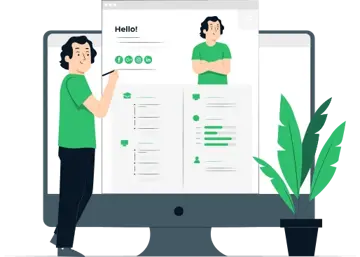
Build your Resume in 15 minutes
Create an awesome resume that meets the expectations of potential employers with our selection of professional, field-tested resume templates.

